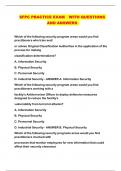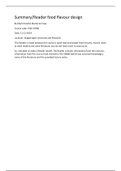Table of Contents
Lecture 1 ....................................................................................................................................................... 4
Heuristics and biases in judgement .......................................................................................................... 4
Context .................................................................................................................................................. 4
Anchoring and adjustment ................................................................................................................... 4
Mental accounting ................................................................................................................................ 4
Availability heuristics ............................................................................................................................ 5
Representative heuristics...................................................................................................................... 5
Prospect theory..................................................................................................................................... 5
Heuristics and biases: definition ............................................................................................................... 6
General conclusion ................................................................................................................................... 6
Lecture 2 ....................................................................................................................................................... 6
Attitude ..................................................................................................................................................... 6
ABC model of attitudes ......................................................................................................................... 7
Attitude-behavior consistency .............................................................................................................. 7
Attitude change: message learning approach .......................................................................................... 8
Advertising and persuasion................................................................................................................... 8
Source characteristics (WHO) ............................................................................................................... 8
Message characteristics (WHAT) .......................................................................................................... 9
Medium characteristics (HOW)........................................................................................................... 10
Recipient characteristics (TO WHOM) ................................................................................................ 11
Lecture 3 ..................................................................................................................................................... 11
Classical or pavlovian conditioning ......................................................................................................... 11
Mere exposure effect & false fame ........................................................................................................ 12
Two-factor theory ............................................................................................................................... 12
Mere exposure effect.......................................................................................................................... 12
Cognitive dissonance .............................................................................................................................. 12
Balance theory ........................................................................................................................................ 13
Self-perception theory ............................................................................................................................ 13
Which theory?......................................................................................................................................... 13
Embodied cognition ................................................................................................................................ 13
Lecture 4 ..................................................................................................................................................... 13
, Influence: science and practice............................................................................................................... 13
Heuristic behavior ................................................................................................................................... 13
Weapons of social influence ................................................................................................................... 13
Reciprocity .......................................................................................................................................... 14
Commitment and consistency ............................................................................................................ 14
Social proof ......................................................................................................................................... 15
Lecture 5 ..................................................................................................................................................... 16
Weapons of influence: part 2 ................................................................................................................. 16
Liking ................................................................................................................................................... 16
Authority ............................................................................................................................................. 16
Scarcity ................................................................................................................................................ 17
Why do people comply and conform?.................................................................................................... 17
Lecture 6 ..................................................................................................................................................... 17
A model of complex decision making ..................................................................................................... 17
Information processing ........................................................................................................................... 18
Exposure.............................................................................................................................................. 18
Attention ............................................................................................................................................. 18
Perception ........................................................................................................................................... 20
Lecture 7 ..................................................................................................................................................... 22
Memory and its functions ....................................................................................................................... 22
The memory process........................................................................................................................... 22
Sensory memory ................................................................................................................................. 23
Short-term memory ............................................................................................................................ 23
Long-term memory ............................................................................................................................. 23
Memory: Schema/semantic network ................................................................................................. 23
Memory/knowledge structure............................................................................................................ 24
Retrieval: accessing information from the schema ................................................................................ 25
Factors that affect what we remember .............................................................................................. 25
How memory is enhanced: Increase the strength of trace length and spreading of activation ........ 26
Retrieval cues ...................................................................................................................................... 26
Retrieval failures ................................................................................................................................. 26
Implications for decision making ............................................................................................................ 26
Stereotype in marketing ..................................................................................................................... 27
,Lecture 8 ..................................................................................................................................................... 27
Problem recognition ............................................................................................................................... 27
Problem recognition/need arousal ..................................................................................................... 27
What is motivation? ............................................................................................................................ 27
Information acquisition/search .............................................................................................................. 29
Internal search: search information from memory ............................................................................ 29
External search: searching for information from the environment ................................................... 30
Lecture 9 ..................................................................................................................................................... 31
High-effort decision-making processes................................................................................................... 31
Attraction effect .................................................................................................................................. 31
Reason-based choice .......................................................................................................................... 31
High-effort feeling-based decisions ........................................................................................................ 31
High-effort thought-based decisions .................................................................................................. 32
Lecture 10 ................................................................................................................................................... 34
Low effort decision making ..................................................................................................................... 34
Simplifying strategies .......................................................................................................................... 34
Dual process model: ELM .................................................................................................................... 36
Miniard et al. (1991) ........................................................................................................................... 37
Message strength vs composition ...................................................................................................... 37
The importance of central route processing – Judgments ................................................................ 38
Lecture 11 ................................................................................................................................................... 39
Post decision dissonance .................................................................................................................... 39
Learning from consumer experience .................................................................................................. 40
How do consumers make satisfaction or dissatisfaction judgements? .............................................. 41
, Lecture 1
Heuristics and biases in judgement
Context
Choices are made in a context: everything is relative, without context choices in absolute terms mean
nothing. In the Ariely experiment, with only two options the majority chooses the internet subscription
only, instead when a third option is added the majority chooses print and internet. The reason is mainly
because customers do not really know what they want, whether only internet or both. When the third
option is being added, people then choose both, rather than print-only.
Anchoring and adjustment
Estimation is often a process of anchoring on a salient number and adjusting up or down; but adjustments
are typically insufficient and the estimation is biased toward the anchor.
For instance, a spinning wheel was used and from that result people had to guess the number of countries
that are in Africa.
Usually lower hanger leads to lower expenses, and the opposite as well; this is why usually expensive stuff
is shown first, in order to set your mind to high prices, making everything else look cheaper.
Mental accounting
People keep track of their expenses in different mental accounts and budgets.
Two different questions:
You are going to a movie. As you stand in line at the box office to buy your ticket, you discover that
you have dropped a € 12 bill on the Metro. You are disappointed, of course, but would this affect your
decision to buy the movie ticket?
Let's say you are headed to a movie. As you are about to enter the theater, you reach into your pocket
and find to your dismay that you have lost your ticket. You don't have a receipt, so if you still want to
see the movie, you have to pay another €12 for a new ticket. Will you play it again?
Lecture 1 ....................................................................................................................................................... 4
Heuristics and biases in judgement .......................................................................................................... 4
Context .................................................................................................................................................. 4
Anchoring and adjustment ................................................................................................................... 4
Mental accounting ................................................................................................................................ 4
Availability heuristics ............................................................................................................................ 5
Representative heuristics...................................................................................................................... 5
Prospect theory..................................................................................................................................... 5
Heuristics and biases: definition ............................................................................................................... 6
General conclusion ................................................................................................................................... 6
Lecture 2 ....................................................................................................................................................... 6
Attitude ..................................................................................................................................................... 6
ABC model of attitudes ......................................................................................................................... 7
Attitude-behavior consistency .............................................................................................................. 7
Attitude change: message learning approach .......................................................................................... 8
Advertising and persuasion................................................................................................................... 8
Source characteristics (WHO) ............................................................................................................... 8
Message characteristics (WHAT) .......................................................................................................... 9
Medium characteristics (HOW)........................................................................................................... 10
Recipient characteristics (TO WHOM) ................................................................................................ 11
Lecture 3 ..................................................................................................................................................... 11
Classical or pavlovian conditioning ......................................................................................................... 11
Mere exposure effect & false fame ........................................................................................................ 12
Two-factor theory ............................................................................................................................... 12
Mere exposure effect.......................................................................................................................... 12
Cognitive dissonance .............................................................................................................................. 12
Balance theory ........................................................................................................................................ 13
Self-perception theory ............................................................................................................................ 13
Which theory?......................................................................................................................................... 13
Embodied cognition ................................................................................................................................ 13
Lecture 4 ..................................................................................................................................................... 13
, Influence: science and practice............................................................................................................... 13
Heuristic behavior ................................................................................................................................... 13
Weapons of social influence ................................................................................................................... 13
Reciprocity .......................................................................................................................................... 14
Commitment and consistency ............................................................................................................ 14
Social proof ......................................................................................................................................... 15
Lecture 5 ..................................................................................................................................................... 16
Weapons of influence: part 2 ................................................................................................................. 16
Liking ................................................................................................................................................... 16
Authority ............................................................................................................................................. 16
Scarcity ................................................................................................................................................ 17
Why do people comply and conform?.................................................................................................... 17
Lecture 6 ..................................................................................................................................................... 17
A model of complex decision making ..................................................................................................... 17
Information processing ........................................................................................................................... 18
Exposure.............................................................................................................................................. 18
Attention ............................................................................................................................................. 18
Perception ........................................................................................................................................... 20
Lecture 7 ..................................................................................................................................................... 22
Memory and its functions ....................................................................................................................... 22
The memory process........................................................................................................................... 22
Sensory memory ................................................................................................................................. 23
Short-term memory ............................................................................................................................ 23
Long-term memory ............................................................................................................................. 23
Memory: Schema/semantic network ................................................................................................. 23
Memory/knowledge structure............................................................................................................ 24
Retrieval: accessing information from the schema ................................................................................ 25
Factors that affect what we remember .............................................................................................. 25
How memory is enhanced: Increase the strength of trace length and spreading of activation ........ 26
Retrieval cues ...................................................................................................................................... 26
Retrieval failures ................................................................................................................................. 26
Implications for decision making ............................................................................................................ 26
Stereotype in marketing ..................................................................................................................... 27
,Lecture 8 ..................................................................................................................................................... 27
Problem recognition ............................................................................................................................... 27
Problem recognition/need arousal ..................................................................................................... 27
What is motivation? ............................................................................................................................ 27
Information acquisition/search .............................................................................................................. 29
Internal search: search information from memory ............................................................................ 29
External search: searching for information from the environment ................................................... 30
Lecture 9 ..................................................................................................................................................... 31
High-effort decision-making processes................................................................................................... 31
Attraction effect .................................................................................................................................. 31
Reason-based choice .......................................................................................................................... 31
High-effort feeling-based decisions ........................................................................................................ 31
High-effort thought-based decisions .................................................................................................. 32
Lecture 10 ................................................................................................................................................... 34
Low effort decision making ..................................................................................................................... 34
Simplifying strategies .......................................................................................................................... 34
Dual process model: ELM .................................................................................................................... 36
Miniard et al. (1991) ........................................................................................................................... 37
Message strength vs composition ...................................................................................................... 37
The importance of central route processing – Judgments ................................................................ 38
Lecture 11 ................................................................................................................................................... 39
Post decision dissonance .................................................................................................................... 39
Learning from consumer experience .................................................................................................. 40
How do consumers make satisfaction or dissatisfaction judgements? .............................................. 41
, Lecture 1
Heuristics and biases in judgement
Context
Choices are made in a context: everything is relative, without context choices in absolute terms mean
nothing. In the Ariely experiment, with only two options the majority chooses the internet subscription
only, instead when a third option is added the majority chooses print and internet. The reason is mainly
because customers do not really know what they want, whether only internet or both. When the third
option is being added, people then choose both, rather than print-only.
Anchoring and adjustment
Estimation is often a process of anchoring on a salient number and adjusting up or down; but adjustments
are typically insufficient and the estimation is biased toward the anchor.
For instance, a spinning wheel was used and from that result people had to guess the number of countries
that are in Africa.
Usually lower hanger leads to lower expenses, and the opposite as well; this is why usually expensive stuff
is shown first, in order to set your mind to high prices, making everything else look cheaper.
Mental accounting
People keep track of their expenses in different mental accounts and budgets.
Two different questions:
You are going to a movie. As you stand in line at the box office to buy your ticket, you discover that
you have dropped a € 12 bill on the Metro. You are disappointed, of course, but would this affect your
decision to buy the movie ticket?
Let's say you are headed to a movie. As you are about to enter the theater, you reach into your pocket
and find to your dismay that you have lost your ticket. You don't have a receipt, so if you still want to
see the movie, you have to pay another €12 for a new ticket. Will you play it again?










